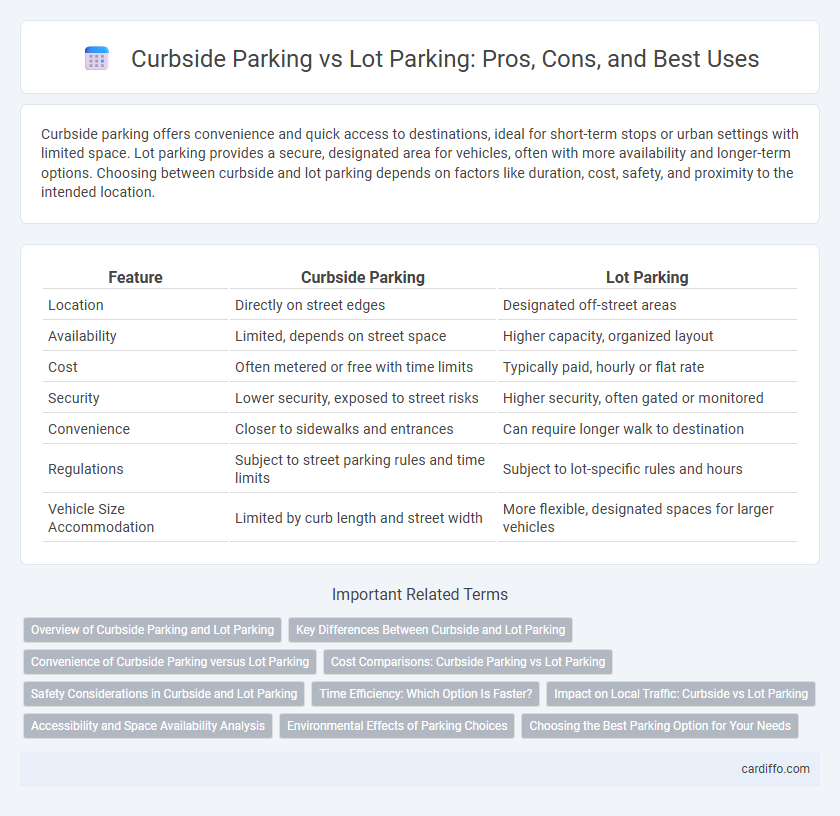Curbside parking offers convenience and quick access to destinations, ideal for short-term stops or urban settings with limited space. Lot parking provides a secure, designated area for vehicles, often with more availability and longer-term options. Choosing between curbside and lot parking depends on factors like duration, cost, safety, and proximity to the intended location.
Table of Comparison
| Feature | Curbside Parking | Lot Parking |
|---|---|---|
| Location | Directly on street edges | Designated off-street areas |
| Availability | Limited, depends on street space | Higher capacity, organized layout |
| Cost | Often metered or free with time limits | Typically paid, hourly or flat rate |
| Security | Lower security, exposed to street risks | Higher security, often gated or monitored |
| Convenience | Closer to sidewalks and entrances | Can require longer walk to destination |
| Regulations | Subject to street parking rules and time limits | Subject to lot-specific rules and hours |
| Vehicle Size Accommodation | Limited by curb length and street width | More flexible, designated spaces for larger vehicles |
Overview of Curbside Parking and Lot Parking
Curbside parking refers to vehicles parked along the street edges, often regulated by signs, meters, or time limits to manage availability and traffic flow. Lot parking involves designated off-street areas, such as parking lots or garages, providing organized spaces that typically offer longer-term parking options and enhanced security. Both curbside and lot parking serve distinct urban mobility needs, balancing convenience, capacity, and regulation.
Key Differences Between Curbside and Lot Parking
Curbside parking offers convenient access by allowing vehicles to park directly along the street, often subject to time restrictions and limited availability. Lot parking provides designated spaces within a controlled area, typically offering more consistent availability and enhanced security features. Differences include cost variations, regulations, and the impact on traffic flow and pedestrian safety.
Convenience of Curbside Parking versus Lot Parking
Curbside parking offers unmatched convenience by allowing drivers to park closer to their destination, reducing walking distance and saving time. Unlike lot parking, which may require navigating large, often crowded spaces and longer treks, curbside spots provide immediate access for quick errands or pickups. This proximity enhances efficiency, making curbside parking ideal for short stays and high-turnover areas.
Cost Comparisons: Curbside Parking vs Lot Parking
Curbside parking generally offers lower costs compared to lot parking due to its convenience and accessibility, often with hourly or metered rates that are typically less expensive than lot fees. Lot parking may involve flat daily rates or higher hourly charges, especially in crowded urban areas or near popular destinations. Budget-conscious drivers frequently opt for curbside options to minimize expenses, though availability and time restrictions can affect overall cost-effectiveness.
Safety Considerations in Curbside and Lot Parking
Curbside parking presents higher safety risks due to increased exposure to moving traffic and limited visibility, leading to greater chances of accidents during entry and exit. Lot parking offers a controlled environment with designated spaces, better lighting, and pedestrian pathways, significantly reducing the likelihood of collisions and enhancing overall safety. Surveillance systems and clear markings in parking lots further contribute to a safer experience compared to curbside options.
Time Efficiency: Which Option Is Faster?
Curbside parking offers quicker access for short-term stops, eliminating the need to locate a parking lot entrance and walk longer distances. Lot parking provides more availability but often requires additional time to navigate aisles and find a space. For time efficiency, curbside parking generally allows faster vehicle withdrawal and arrival in urban areas with moderate traffic.
Impact on Local Traffic: Curbside vs Lot Parking
Curbside parking often disrupts local traffic flow by narrowing lanes and causing frequent stops, leading to congestion and slower movement on busy streets. Lot parking, located off the main road, reduces interference with through traffic and minimizes bottlenecks, improving overall traffic efficiency. Urban planning that prioritizes lot parking can alleviate street-level congestion and enhance safety for both drivers and pedestrians.
Accessibility and Space Availability Analysis
Curbside parking offers greater accessibility for quick stops due to its proximity to entrances and pedestrian pathways, while lot parking provides more space availability with designated spots that can accommodate larger vehicles and longer stays. Lot parking often features organized layouts and signage that improve navigation and reduce congestion compared to limited and sometimes irregular curbside spots. Accessibility challenges in curbside parking include restricted hours and potential blockage by delivery vehicles, whereas lot parking ensures continuous availability but may require longer walking distances.
Environmental Effects of Parking Choices
Curbside parking reduces the need for expansive paved areas, minimizing heat island effects and preserving green spaces, which helps improve urban air quality. Lot parking often involves large impervious surfaces that increase stormwater runoff, contributing to water pollution and habitat disruption. Choosing curbside parking over large lots can lead to decreased carbon emissions through shorter walking distances and reduced reliance on vehicle circulation within parking areas.
Choosing the Best Parking Option for Your Needs
Curbside parking offers quick access and convenience for short-term stops, often located directly on streets with time limits and meter fees. Lot parking provides more secure spaces and longer durations, typically with higher capacity in designated parking areas or garages. Consider factors such as duration of stay, location proximity, and cost when choosing between curbside and lot parking options for optimal convenience and value.
Curbside parking vs Lot parking Infographic

 cardiffo.com
cardiffo.com